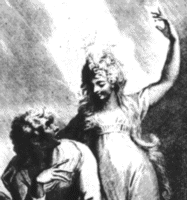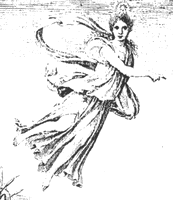

An introduction to astronomy in a series of letters, from a preceptor to his pupil ...
London, J. Johnson, 1786.
pp. [2], VI, [2], 432, 20 plates. 8°.
DCC - 4° - 389
Poggendorff
 Urania's calling is to raise her followers from the contemplation of terrestrial
things to the heavens: this idea is well illustrated in the
frontispiece
of the Introduction to astronomy by the British John Bonnycastle.
Urania's calling is to raise her followers from the contemplation of terrestrial
things to the heavens: this idea is well illustrated in the
frontispiece
of the Introduction to astronomy by the British John Bonnycastle.
Author of the engraving is John Keyes Sherwin (London 1751-1790), whose favourite sacred and mythological subjects were generally executed with the burin. The frontispiece presents a young woman with a bright star on her brow, indicating the sky over her to a man, sitting in a disheartened attitude near a terrestrial globe.
John Bonnycastle (Whitechurch, d. 1821), coming from a modest family, attended to mathematic and literary studies: he became an expert in Latin, Greek, Italian, French and German literatures. He held a course of mathematics at Woolwich Military Academy until he died.
Praecipuarum stellarum inerrantium positiones mediae ineunte saeculo XIX. Ex observationibus habitis in Specula Panormitana ab anno 1792 ad annum 1813.
Panormi, ex Regia Typographia Militari, 1814.
pp. [12], 178, VIII, [2]. 4°.
DCCC - f° - 31
Poggendorff
 Giuseppe Piazzi's catalogue of 7646 stars was a milestone in XIXth
century astronomy, deriving from a long series of observations made at Palermo
Astronomical Observatory. Piazzi was the first director of the Observatory,
built in 1790 on the initiative of the Viceroy of Sicily. The catalogue was
first published in 1803, then it appeared in its definitive version in 1814.
Giuseppe Piazzi's catalogue of 7646 stars was a milestone in XIXth
century astronomy, deriving from a long series of observations made at Palermo
Astronomical Observatory. Piazzi was the first director of the Observatory,
built in 1790 on the initiative of the Viceroy of Sicily. The catalogue was
first published in 1803, then it appeared in its definitive version in 1814.
The engraving depicting Urania was made by Francesco Ognibene (Palermo 1785-1837), a painter from the school of Vincenzo Riolo in Palermo, whose paintings of religious subject can still be seen in the Sicilian churches. Ognibene also painted mythological frescoes. In Piazzi's catalogue the engraving shows a woman floating in the air, some stars on her brow, pointing to Ramsden's circle. Two putti are playing with the astronomical instrument, while a marine deity is sitting in the left corner, pouring water from a vase.
Giuseppe Piazzi (Ponte 1746-1826), formerly a pupil of Lalande, equipped the Observatory of Palermo with a vertical circle, expressly ordered to Ramsden's workshop; at those times Ramsden was the most famous craftsman in optical instruments, and with his circle the astronomical observations were started in Palermo. On January 1st 1801 Piazzi discovered the planetoid he named Cerere ferdinandea in honour of King Ferdinando Borbone; for his discovery Piazzi was awarded special prizes by the Crown of the Two Sicilies and by the French Academy.



| Biblioteca del Dipartimento di Astronomia Pierluigi Battistini, Laura Peperoni e Marina Zuccoli |